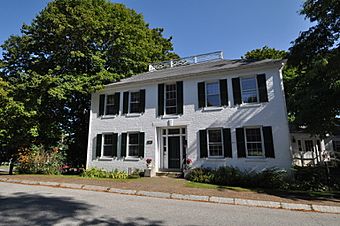Wiscasset Historic District facts for kids
Quick facts for kids |
|
|
Wiscasset Historic District
|
|

The Wiscasset Public Library
|
|
| Location | Roughly Parker, Dresden, Bradford, Main, and Federal Sts., Wiscasset, Maine |
|---|---|
| Area | 101 acres (41 ha) |
| Architectural style | Greek Revival, Federal, Octagon |
| NRHP reference No. | 73000242 |
| Added to NRHP | January 12, 1973 |
The Wiscasset Historic District is a special area in Wiscasset, Maine, covering about 101 acres (41 hectares). It includes many old and important buildings, some dating back to the 1700s. This district shows off the history of Wiscasset, especially when it was a busy port town.
Wiscasset is known for its beautiful Federal style buildings. Most of these were built between 1780 and 1820. One very famous building here is the Nickels-Sortwell House, which is even a National Historic Landmark. The entire district was added to the National Register of Historic Places in 1973.
Contents
Exploring Wiscasset's Past
Wiscasset is located on the western side of the Sheepscot River. This spot was perfect for a deep, safe harbor. European settlers first arrived here in the 1670s. However, conflicts with Native American tribes meant that many people didn't settle permanently until the 1760s.
The town was first part of a larger area called Pownalborough in 1760. Later, in 1794, Wiscasset became its own town. It also became the main town, or shire town, for Lincoln County.
Wiscasset's Golden Age
Wiscasset grew into a very important center for shipbuilding and trade. Ships were built here, and goods were bought and sold through its busy port. This period was very successful for the town.
However, this prosperity didn't last forever. The Embargo Act of 1807 and the War of 1812 greatly harmed Wiscasset's economy. Trade slowed down, and the town's growth stopped. Since then, Wiscasset has not seen the same level of economic success. This slowdown helped preserve many of its historic buildings.
Famous Buildings in the District
During its most prosperous time, many grand Federal-style buildings were constructed. You can find these beautiful homes and public buildings along the town's streets, especially near United States Route 1.
One of the most famous buildings is the Nickels-Sortwell House. Built in 1805, it's considered one of the best examples of Federal architecture in the entire country. It's now a museum that you can visit.
Other notable buildings include:
- The Wiscasset Public Library, which is located in a large brick mansion built in 1805.
- The former Wiscasset Academy building, constructed in 1807. It now houses an art gallery.
- The Capt. George Scott House, which is an unusual octagonal (eight-sided) building.
- The Wiscasset Jail and Museum, built in 1809. It's one of Maine's oldest surviving jails and is also open to the public as a museum.
Important Historic Places
The Wiscasset Historic District includes many significant buildings and sites. Here are a few examples that show the town's rich history:
- Ancient Cemetery: This cemetery has gravestones dating back to 1739, showing how old the settlement is.
- Judge Rice House: Built before 1766, it's one of the oldest homes in the district.
- Nickels-Sortwell House: As mentioned, this 1807 house is a National Historic Landmark and a must-see example of Federal architecture.
- Castle Tucker: Built between 1807 and 1808, this house has unique elliptical (oval-shaped) stairs.
- Wiscasset Academy: This building from 1807 was once a school and is now an art gallery.
- Wiscasset Jail and Museum: Built in 1809, this old jail offers a look into the past.
- Old Customhouse: Constructed in 1869-70, this building once handled goods coming into and out of the port.
- Lincoln County Courthouse: This courthouse was built in 1824.
- Wiscasset Public Library: Originally a brick house from 1805, it has served many purposes before becoming the town library in 1929.
These buildings and sites help tell the story of Wiscasset's past as a bustling port town and its journey through history.



